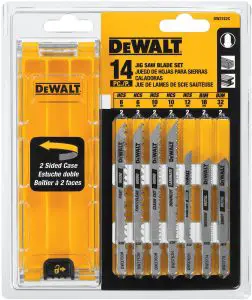Table of Contents
Introduction
You may have just bought a jigsaw, and you are ready to use it for your projects, but you’re wondering if it is the right blade you are using for a particular project or if jigsaw blades are universal. There are varying types of jigsaw blades you can find in the market. However, most of the time, jigsaw blades are advertised according to the material they can work on.
There is a type of blade called the universal blade or U-shank, but this does not mean that every jigsaw blade is universal. The name only tells you the type of shank that is compatible with a particular jigsaw. Different jigsaws are compatible with different shanks, so you need to know which blade is compatible with your jigsaw. The shank is the part of the jigsaw blade that attaches to the tool.
Different types of jigsaw blades are suitable for cutting into different types of materials. The blade you purchase will determine what kind of material you can efficiently cut through, the cutting speed and the look of the final cut. To further help you understand, we will be taking a deeper look into the two ways jigsaw blades are classified.
The Blade’s Shank
Jigsaw blades are mainly categorized by the type of shank they possess. The shank is the part of the blade that is attached to the clamp of the jigsaw. There are two alternatives, the U-shank (universal shank) and the T-shank (tang shank).
The T-shank blades are the most popular and widely used jigsaw blade available in the market. They have a tang at their top that easily fits into the blade clamp of your jigsaw. They were introduced after the U-shank to reduce the changing time. The T-shank blades are compatible with almost every modern jigsaw you can find at the store today.
The U-shank Blade has a U shape cut at its top. They used to be the most common type od jigsaw blade for years but lost their popularity when the T-shank was introduced. They had to be attached using a screw or key, and this made the changing process slow. However, they are still available for purchase on the market because a lot of the old jigsaws only accept the U-shank blade.
An extra fact to know is that Ryobi produced an “all-purpose jigsaw kit”. You could call these blades universal because they include both the T-shank and U-shank. If you own an old jigsaw and you’re not sure what type of blade you should get, then this kit will be a good place to start.
Blade Material
There are other factors that are used in knowing which jigsaw blade you will need to use. Another important feature to consider apart from the shank type is the material the blade is constructed out of. The material of a jigsaw blade will determine what kind of material it can cut through and its durability. It means, the harder the material you are working with, the harder the blade’s material should be. Most jigsaw blades are made from four different metals, and they are high carbon steel, tungsten carbide, bi-metal and high-speed steel.
High Carbon Steel Blades
They are the most common type of jigsaw blade material. They have a great balance between price and quality. They are best suited for woodworking jobs, but they also used on soft materials such as PVC. Keep in mind that if you use them on hard materials, they are going to wear out quickly.
Tungsten Carbide Blades
These blades are used only for specific applications. They are commonly used in cutting through tiles or cement. They are the most expensive and most times; they are toothless. More often than not, you will find that a thin layer of tungsten carbide has been applied to the cutting edge instead of having a set of teeth.
Bi-Metal Blades
These blades are made out of two major materials. The teeth are made out of high-speed steel (HSS) while the rest of the blade is constructed from high carbon steel (HCS). It has the best features of both blades; these blades are flexible but also suitable for cutting hard materials. They are more expensive than the high speed steel blades, but if you intend on using your jigsaw a lot, then this will be a good investment.
High-Speed Steel Blades
These blades are used majorly for cutting metal. They are stronger than the high carbon steel blades but also stiff, so you won’t be able to cut curves like you can with the HCS blades.
Conclusion
A jigsaw is a versatile power tool as long as you choose the right blade for it. It can handle a variety of materials and applications. All you have to do is find the shank that is compatible with your jigsaw and also the style of blade that is suitable for the material you intend on working on.

